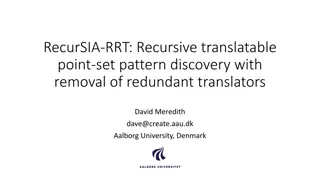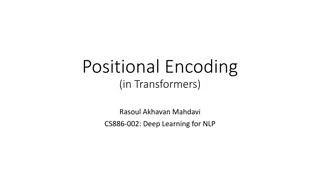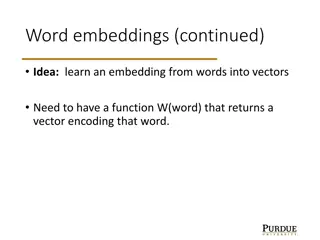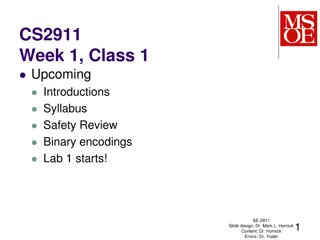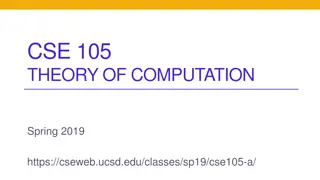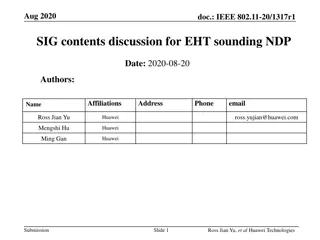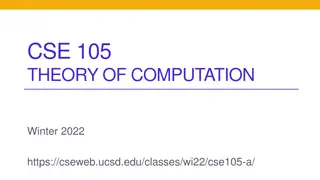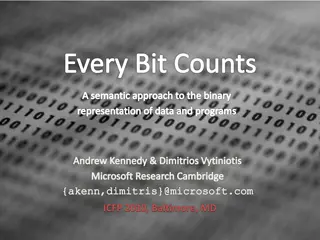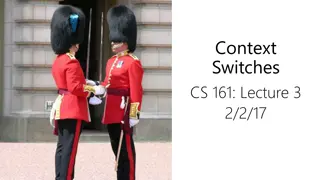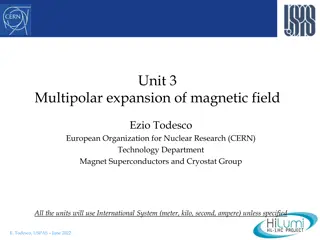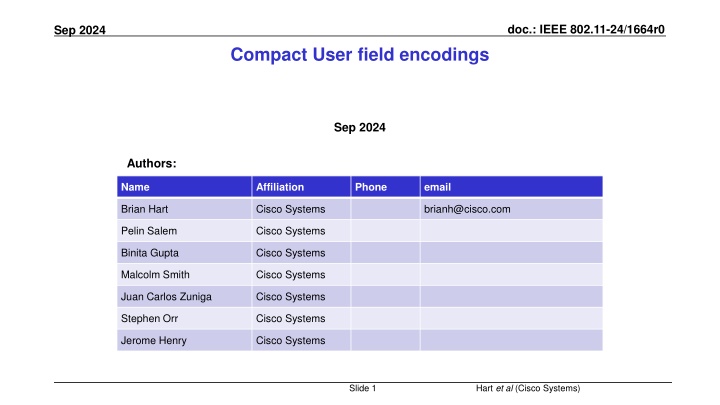
Efficient User Field Encoding in IEEE 802.11-24/1664r0 Sep. 2024
Explore compressed encodings to address the issue of increasing parameters in the User field of IEEE 802.11-24/1664r0 Sep. 2024, aiming to optimize bit allocation and accommodate various device complexities and capabilities.
Download Presentation

Please find below an Image/Link to download the presentation.
The content on the website is provided AS IS for your information and personal use only. It may not be sold, licensed, or shared on other websites without obtaining consent from the author. If you encounter any issues during the download, it is possible that the publisher has removed the file from their server.
You are allowed to download the files provided on this website for personal or commercial use, subject to the condition that they are used lawfully. All files are the property of their respective owners.
The content on the website is provided AS IS for your information and personal use only. It may not be sold, licensed, or shared on other websites without obtaining consent from the author.
E N D
Presentation Transcript
doc.: IEEE 802.11-24/1664r0 Sep 2024 Compact User field encodings Sep 2024 Authors: Name Affiliation Phone email Brian Hart Cisco Systems brianh@cisco.com Pelin Salem Cisco Systems Binita Gupta Cisco Systems Malcolm Smith Cisco Systems Juan Carlos Zuniga Cisco Systems Stephen Orr Cisco Systems Jerome Henry Cisco Systems Slide 1 Hart et al (Cisco Systems)
doc.: IEEE 802.11-24/1664r0 Sep 2024 Executive Summary Situation[3]-[6] More PHY features in UHR requires more parameters to be signaled in the User field Legacy User field is 22 bits Separate fields for NSS, MCS, UEQM pattern are simplest Problem Current direction is 3-4b for NSS, 5b for MCS, 1b for (U)EQM, 2b for UEQM patterns, 1b for 2xLPDC a lot of bits, and will exceed 22 bits Solution Explore compressed encodings while recognizing the spectrum of device complexity Slide 2 Hart et al (Cisco Systems)
doc.: IEEE 802.11-24/1664r0 Sep 2024 Situation and Problem: Current direction for User field bit allocation leads to a substantial increase in the size of the User field Field 11be Current direction for 11bn MCS 4 5 MCS as a distinct field in failed Motion 41[2] Reserved 1 0 ? NSS 4 3 (or 4*?) NSS as a distinct field in failed Motion 41[2] isUEQM 0 1 1b in passed Motion 40[2] UEQM Pattern 0 2 Pattern as a distinct 2b field in failed Motion 41[2] Subtotal 9 11 (or 12*?) STA-ID 11 11? Following legacy isBeamformed 1 1? Following legacy isLdpcCoding 1 1? Following legacy is2xLDPC 0 1? Total 22 25 (or 26*?) *A desire was expressed to leave room to continue to enable (VS signaling of) up to 16SS Slide 3 Hart et al (Cisco Systems)
doc.: IEEE 802.11-24/1664r0 Sep 2024 11 or 12 bits for (NSS,MCS,isUEQM,UEQM-pattern) is inefficient due the relatively low entropy in each field UEQM is not defined for NSS = 1/5/6/7/8 The lowest constellations defined per code rate cannot use UEQM See next slide The second-lowest constellations defined per code rate cannot use UEQM involving constellationIndex-2 See next slide 18 MCSs need just log2(18) = 4.17b Also, if we continue EHT MCS 14 and 15, they are only defined for NSS = 1 2/3/4 SS have 2/3/4 UEQM patterns respectively; but many (client) devices do not support 4SS Indeed, devices exist on a spectrum, from very low capability to very high capability Product Tier Very low NSS 1 MCS No more than 16 (e.g., 0-7, 0-9, 0-11, or 0-13; and perhaps EHT MCS14-15 0-17 0-17 0-17 0-17 EQM/UEQM? N/A Low Mid High Very high 2 3 4 8 (or perhaps 16*) Y (EQM + 2 patterns) Y (EQM + 2/3 patterns) Y (EQM + 2/3/4 patterns) Y (EQM + 2/3/4 patterns) Slide 4 Hart et al (Cisco Systems)
doc.: IEEE 802.11-24/1664r0 Sep 2024 How many (NSS,MCS,isUEQM,UEQM-pattern)-tuples are there? Just 246+2, which fits into 8b Count up the number of distinct tuples, noting that many NSSs and MCSs cannot use certain UEQM patterns Code Rate SS #UEQM M-1 patterns #UEQM M-2 patterns 1 2 3 4 NSS #EQM Total 1/2 2/3 3/4 5/6 NSS Constellation BPSK QPSK 16QAM 64QAM 256QAM 1KQAM 4KQAM 2 2 3 3 3 4 4 4 4 M M M M M M M M M M-1 M-2 M M M-1 M M M M-1 1 2 3 4 5 6 7 8 18+2& 18 18 18 18 18 18 18 144+2& 18 42 52 62 18 18 18 18 MCS0 MCS1 MCS2 MCS4 MCS5 14 14 14 10 MCS3 MCS6 MCS9 MCS10 M-1 M-2 M-2 M M M-1 M-1 10+10 10+10+10 MCS7 MCS8 MCS11 MCS12 MCS13 MCS14 MCS15 MCS16 MCS17 M-1 M-2 M-2 M-2 Total 42 60 246+2& Orange = no UEQM possible Yellow+Green = M-1 UEQM pattern is possible (one pattern for 14 MCSs and NSS=2/3/4) Green = M-2 UEQM patterns are possible (1/2/3 patterns for NSS = 2/3/4 respectively; for 10 MCSs) Yellow = M-1 UEQM patterns Green = M-2 UEQM patterns &+2 assuming we carry forward EHT MCS 14 and 15 for NSS = 1 Slide 5 Hart et al (Cisco Systems)
doc.: IEEE 802.11-24/1664r0 Sep 2024 Corollary: We have great freedom to encode these tuples Although we have 8b is possible, we have the choice of 8 (or 9/10/11) bits to express the (NSS,MCS,isUEQM,UEQM-pattern)-tuples And we have complete freedom to assign a (NSS, MCS, EQM/UEQM, UQMpattern)-tuple to any 8/9/10/11b value What do we optimize for? Proposed design principle: Lower-capability devices should be given less (de)compression work to do (e.g., bit slicing) Since they are appreciably helped by a low-complexity encoding Higher-capability devices should bear the brunt of the (de)compression work Since they can amortize a more complicated compression scheme - Via a small Look-Up Table (e.g., HW ROM which might be synthesized to just a few gates; or an array in SW), or - Via if+else/switch statements (e.g., HDL gates if HW, or code if SW) Slide 6 Hart et al (Cisco Systems)
doc.: IEEE 802.11-24/1664r0 Sep 2024 Example for Context: Optimizing for very low to low-tier devices, given an 8b field Product Tier NSS MCS Very low to low Bit allocation Nominally 1 bit Nominally 5 bits EQM/UEQM Y (EQM + 2 patterns) 1-2 0-17 Nominally 2 bits (NSS=2 only needs to signal EQM and two more UEQM patterns) Some values are unused and can be repurposed to encode NSS=3-8 with EQM+UEQM + EHT MCS14+15 Impact on higher-tier devices NSS3-8 use the unused values Values 18-31 are unused and can be repurposed to encode NSS=3-8 with EQM+UEQM + EHT MCS14+15 EQM/UEQM pattern 0 1 2 3 EQM/UEQM pattern 0 1 2 3 NSS = 2 NSS = 1 MCS MCS 18 used values 0-17 0-17 18+14+10=42 used values 128-18 = 110 unused values 128- 18-14-10= 86 unused values 18-31 18-31 As a secondary allocation, the remaining 246-18-42+2 = 186+2 tuples (NSS=3-8 with EQM+UEQM + EHT MCS14+15) can be blockwise assigned to the 110+86 = 196 remaining values[1] (Very) Low capability devices never use these more complex tuples, so these tuples encoding is a don t care Slide 7 Hart et al (Cisco Systems)
doc.: IEEE 802.11-24/1664r0 Sep 2024 But there are many other possible encodings we can consider, with different pros and cons. Some more promising options are: Best for these product tiers #tuple bits NSS Nominal MCS Nominal EQM/UEQM Nominal #Secondary values #Secondary blocks #Secondary compressed blocks #Secondary blocks not aligned with power of 2 #Secondary small blocks Very low + low 8 1b (1-2SS) 5b (0-17) 2b (EQM + 3 patterns) 186 15 6 2 11 Ditto + mid (OK for high) 9 2b (1-4SS) 5b (0-17) 2b (EQM + 3 patterns) 82 6 0 1 0 Ditto + high 10 2b (1-4SS) 5b (0-17) 3b (EQM + 4 patterns) 72 4 0 0 0 Ditto + very high 11 3b (1-8SS) 5b (0-17) 3b (EQM + 4 patterns) 0 0 0 0 0 Very low (OK for low, mid, high) 8 2b (1-4SS) 4b (0-15) 2b (EQM + 3 patterns) 106 25 0 21 13 #Secondary values = number of values used outside of nominal #Secondary blocks = number of blocks with the same NSS + EQM/UEQMpattern (i.e., after aggregating over MCSs) that are positioned outside of nominal #Secondary compressed blocks: given UEQM with M-1 (14 MCSs) or M-2 (10 MCSs), number of blocks where these (14 or 10) MCSs are allocated contiguously (and are positioned outside of nominal) #Secondary blocks not aligned with power of 2: number of blocks where the lowest actual MCS (i.e., MCS0; or higher in a compressed block) doesn t align with a nominal MCS0 #Secondary small blocks: number of blocks with 4 entries or fewer Slide 8 Hart et al (Cisco Systems)
doc.: IEEE 802.11-24/1664r0 Sep 2024 Summary We are currently heading towards 11 bits to indicate the (NSS,MCS,isUEQM,UEQM-pattern)-tuples This enables trivial bit slicing for all implementations, but grows the User field We show that there are only 246+2 (NSS,MCS,isUEQM,UEQM-pattern)-tuples in total So we can choose to allocate 8/9/10 bits for these tuples instead The mapping from (NSS,MCS,isUEQM,UEQM-pattern)-tuple to field value may be based on: a primary assignment that enables simple clean bit slicing up to a max tuple and a secondary assignment thereafter (using the unused values from the primary assignment) Slide 9 Hart et al (Cisco Systems)
doc.: IEEE 802.11-24/1664r0 Sep 2024 References [1] 24/1665 Compact User field encodings detailed examples , Brian Hart [2] 24/0171, TGbn Motions List - Part 1 , Alfred Asterjadhi [3] 24/1411, Signaling for UHR PPDU , Ross Jian Yu [4] 24/1427, Signaling for MCS and UEQM in 11bn , Dongguk Lim [5] 24/1431, A-Unified-Signaling-Scheme-for-EQM-and-UEQM , Aiguo Yan [6] 24/1461 UHR preamble signaling , Sigurd Schelstraete Slide 10 Hart et al (Cisco Systems)
doc.: IEEE 802.11-24/1664r0 Sep 2024 Strawpoll 1 Do you agree to remove the following text from the 11bn SFD: For a (non-ELR) UHR MU PPDU, there exists a 1-bit EQM/UEQM indication in a User field for non-MU- MIMO in the UHR-SIG field. Do you agree to add the following text to the 11bn SFD: The fields related to NSS, MCS, isUEQM, and UEQM-pattern in the User field enable simple bit slicing for lower-capability devices The fields related to NSS, MCS, isUEQM, and UEQM-pattern in the User field may be allocated 8/9/10/11 bits (TBD) Y / N / A Slide 11 Hart et al (Cisco Systems)
doc.: IEEE 802.11-24/1664r0 Sep 2024 Backup (see also [1] for details) Slide 12 Hart et al (Cisco Systems)
doc.: IEEE 802.11-24/1664r0 Sep 2024 Optimizing for very low to low-tier devices, given an 8b field Product Tier Very low to low Bit allocation NSS 1-2 MCS 0-17 EQM/UEQM Y (EQM + 2 patterns) Nominally 1 bit Nominally 5 bits Nominally 2 bits (NSS=2 only needs to signal EQM and two more UEQM patterns) Some values are unused and can be repurposed to encode NSS=3-8/more UEQM patterns/EHT MCS14+15 Impact on higher-tier devices NSS3-8 use the unused values Values 18-31 are unused and can be repurposed to encode NSS=3-8/more UEQM patterns/EHT MCS14+15 EQM/UEQM pattern 0 1 2 3 EQM/UEQM pattern 0 1 2 3 NSS = 2 NSS = 1 MCS MCS 18 used values 0-17 0-17 18+14+10=42 used values 128-18 = 110 unused values 128- 18-14-10= 86 unused values 18-31 18-31 As a secondary allocation, the remaining 246-18-42+2 = 186+2 tuples (NSS=3-8 with EQM+UEQM + EHT MCS14+15) can be blockwise assigned to the 110+86 = 196 remaining values[1] (Very) low capability devices never use these more complex tuples, so these tuples encoding is a don t care Slide 13 Hart et al (Cisco Systems)
doc.: IEEE 802.11-24/1664r0 Sep 2024 Optimizing for mid tier devices, given a 9b field Product Tier Mid NSS 1-4 MCS 0-17 EQM/UEQM Y (EQM + 3 patterns) Bit allocation Nominally 2 bits Nominally 5 bits Nominally 2 bits (NSS=3 only needs to signal EQM and three more UEQM patterns) Impact on higher-tier devices NSS=4 is unused; NSS4-8 use the gaps Some combinations of these values are unused and can be repurposed to encode NSS=4-8/4th UEQM pattern/EHT MCS14+15 EQM/UEQM pattern 0 1 2 3 NSS = 1/2 Same as previous slide NSS = 3 MCS 0-17 18+14+10+10=52 used values 3*18+4*14 = 110 unused values As a secondary allocation, the other 246-18-42-52+2 = 134+2 tuples (NSS=4-8 with 4th UEQM pattern + EHT MCS14+15) can be blockwise assigned to the 110+86+76+128 = 400 remaining values[1] Very low/low/mid capability devices never use these more complex tuples, so these tuples encoding is a don t care for the devices Plenty of space for 16SS too 18-31 128-18-14-10-10 = 76 unused Slide 14 Hart et al (Cisco Systems)
doc.: IEEE 802.11-24/1664r0 Sep 2024 Optimizing for high tier devices, given a 9b field Product Tier High NSS 1-4 MCS 0-17 EQM/UEQM Y (EQM + 4 patterns) Bit allocation Nominally 2 bits Nominally 5 bits Wants 3 bits but allocate 2 nominal bits. NSS=4 with the 4th pattern doesn t fit, must use the secondary allocation Impact on higher-tier devices NSS5-8 use the unused values Some combinations of these values are unused and can be repurposed to encode NSS=5-8/4th UEQM pattern/EHT MCS14+15 = 1/2/3 EQM/UEQM pattern 0 1 2 3 NSS Same as previous slides NSS = 4 MCS 0-17 18+14+10+10=52 used values 3*18+4*14 = 110 unused values As a secondary allocation, the other 246-18-42-52-62+ 10+2 = 82+2 tuples (NSS=4 with 4th UEQM pattern, NSS=5-8 + EHT MCS14+15) can be blockwise assigned to the 110+86+76+76 = 348 remaining values[1] For (very) low/mid tier devices never use these more complex tuples, so these tuples encoding is mostly a don t care for the devices. For high tier devices, due to 4SS + 4thUEQM pattern, these tuples encoding is mostly a don t care. Plenty of space for 16SS too 18-31 128-18-14-10-10 = 76 unused Slide 15 Hart et al (Cisco Systems)
doc.: IEEE 802.11-24/1664r0 Sep 2024 Optimizing for high tier devices given a 10b field Product Tier High NSS 1-4 MCS 0-17 EQM/UEQM Y (EQM + 4 patterns) Bit allocation Nominally 2 bits Nominally 5 bits Nominally 3 bits Impact on higher-tier devices NSS5-8 use the unused values Some combinations of these values are unused and can be repurposed to encode NSS=5-8/EHT MCS14+15 NSS=1: 256 18 = 238 unused; NSS=2: 256 42 = 214 unused NSS=3: 256 52 = 204 unused; NSS=4: 256 62 = 194 unused; Total of 850 unused values As a secondary allocation, the other 18+18+18+18+2 =72+2 tuples (NSS=5-8 + EHT MCS14+15) can be blockwise assigned to the 850 remaining values Very low/low/mid/high capability devices never use these more complex tuples, so these tuples encoding is mostly a don t care for the devices Plenty of space for 16SS too Slide 16 Hart et al (Cisco Systems)


